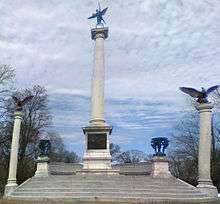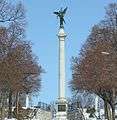Elijah P. Lovejoy Monument
The Elijah P. Lovejoy Monument, also known as the Elijah Lovejoy Monument, Elijah Parrish Lovejoy Shaft, Lovejoy Monument, and Lovejoy State Memorial,[1] is a memorial in Alton, Illinois, to the advocate of free speech and the abolition of slavery, who died fighting for these ideas when his newspaper, the Alton Observer, was attacked and destroyed by pro-slavery fanatics.
| Lovejoy Monument | |
|---|---|
 The 110 foot tall spire of the Lovejoy monument | |
| Location | Alton, Illinois |
| Coordinates | 38°53′24.5″N 90°09′57.2″W |
| Area | 106.01 acres (0.4290 km2) |
| Established | 1897 |
| Built | 1897 |
| Architect | R. P. Bringhurst |
| Visitors | 467,550 (in 2005) |
| Governing body | Greater Alton/Twin Rivers Convention and Visitors Bureau |
 Location of Lovejoy Monument in the United States | |
History
Elijah P. Lovejoy was an abolitionist in the 1830s, running a newspaper called the St Louis Observer, in Missouri, a slave state. Slavery advocates attacked and destroyed his presses a number of times, driving him to move across the river to Alton, IL in 1837, where he renamed it the Alton Observer. Although Illinois was a free state, in November 1837, his presses were attacked for what would have been the fourth time. He and some supporters were in the warehouse where they were stored, and as the building was stormed, the attackers apparently began firing guns. Lovejoy and his men returned fire, but in the conflict Lovejoy was killed.[2]
His death garnered national attention, and was viewed by abolitionists and others as a tragic martyrdom in the cause of both freedom of speech and the abolition of slavery. Abraham Lincoln is quoted as saying:
Lovejoy's tragic death for freedom in every sense marked his sad ending as the most important single event that ever happened in the new world[3]
- - Abraham Lincoln, letter to friend Lemen, in 1857
Having been buried in an unmarked grave, Lovejoy's remains were exhumed years later, and placed in the cemetery that is now overlooked by his monument.
In the 1890s, work began in earnest on his monument. It was designed by R. P. Bringhurst, a St. Louis sculptor, and built by Culver Stone Company of Springfield, Illinois.[4]
Structure
The monument consists of a 93 foot tall main shaft topped by a 17-foot-tall winged statue of victory, which therefore stands over 300 feet above the Mississippi river below, with two side spires mounted by eagles, as well as two bronze lion chalice statues, and a stone whispering wall bench that wraps all the way around the central spire, allowing you to hear someone whispering completely out of sight on its opposite side.
Because it is based on the top of the river bluffs, the monument is easily seen from the distance, even when crossing the bridge over the Mississippi, from Missouri into Illinois, a considerable distance away.
The four sides of the central spire's pedestal contain quotes by Lovejoy, focusing on each aspect of his life:
Champion of Free Speech.
- But, gentlemen, as long as I am an American citizen, and as long as American blood runs in these veins, I shall hold myself at liberty to speak, to write, to publish whatever I please on any subject--being amenable to the laws of my country for the same.
Salve, Victores!
- This monument commemorates the valor, devotion and sacrifice of the noble Defenders of the Press, who, in this city, on Nov. 7, 1837, made the first armed resistance to the aggressions of the slave power in America.
Minister of the Gospel.
Moderator of Alton Presbytery,
- If the laws of my country fail to protect me I appeal to God, and with him I cheerfully rest my cause. I can die at my post but I cannot desert it.
Elijah P. Lovejoy,
Editor Alton Observer,
Albion, Maine, Nov. 8, 1802
Alton, Ill., Nov. 7, 1837.
A Martyr to Liberty.
- I have sworn eternal opposition to slavery, and by the blessing of God, I will never go back.
Gallery
 Panoramic photo of the entire monument
Panoramic photo of the entire monument This whispering wall wraps all the way around the monument to let people whisper out of sight on the opposite side
This whispering wall wraps all the way around the monument to let people whisper out of sight on the opposite side Map showing the monument as "You are Here"
Map showing the monument as "You are Here" Lion chalice
Lion chalice The monument, as seen from the street
The monument, as seen from the street Plaque on the front of the monument
Plaque on the front of the monument Monument looking up from Monument Avenue. This photo edited to remove the power lines
Monument looking up from Monument Avenue. This photo edited to remove the power lines- First Block of Elijah Lovejoy's story to the left of the monument
- Second block of Elijah Lovejoy's story to the left of the monument at the top of the steps
- Storyboard to the right of the monument